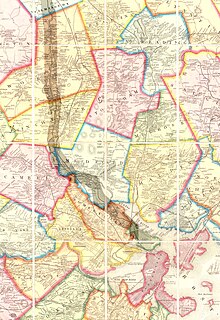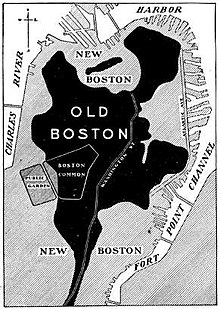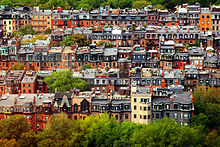Back Bay (Boston)
| Back Bay Historic District | ||
|---|---|---|
| National Register of Historic Places | ||
| Historic District | ||
|
Back Bay from Charles River seen from |
||
|
|
||
| location | Boston , Massachusetts | |
| Coordinates | 42 ° 21 '4.7 " N , 71 ° 4' 49.3" W | |
| Built | 19th century | |
| NRHP number | [1] 73001948 | |
| The NRHP added | 17th August 1973 | |
Back Bay is a historic district ( Neighborhood ) of the city of Boston in the state of Massachusetts in the United States . Together with neighboring Beacon Hill , there were 27,476 residents in 2010. The Back Bay Historic District is famous for its Victorian sandstone houses , considered some of the best preserved examples of 19th century urban design in the United States. There are also many other buildings in the district that are very interesting from an architectural point of view, as well as important cultural institutions such as the Boston Public Library . The largest building in town , the Hynes Convention Center , is also in the Back Bay district .
Before the landfill measures carried out in the 19th century, there was an actual bay at the site of the current district . Today, the neighborhood, along with Beacon Hill, is one of the most expensive areas in all of Boston.
geography
Expansion of the urban area
According to the Neighborhood Association of the Back Bay , the boundaries of the neighborhood are as follows:
- North: Charles River
- East: The section from Arlington Street to Park Square
- South: The stretch from Columbus Avenue to the tracks of the New York, New Haven and Hartford Railroad at Copley Place , Huntington Avenue , Dalton Street and the Massachusetts Turnpike
- West: Charlesgate East
City structure
A little known district in Back Bay is St. Botolph or formally Saint Botolph Architectural Conservation District . The area extends north to south from Huntington Avenue to the Southwest Corridor and west to east from Massachusetts Avenue to Harcourt Avenue . In this district there are almost exclusively sandstone houses.
history

Before land reclamation projects were carried out in the 19th century, Back Bay was a bay on the west of the Shawmut Peninsula , on the opposite side of Boston Harbor between Boston and Cambridge , into which the Charles River flowed from the west. The bay was subject to the tides , so the water level fluctuated several feet a day and turned the bay into a swampy landscape at low tide . Already 5,200 years ago, Indians built their fish weirs here , the remains of which were discovered in the course of construction work for the Boston subway in 1913.
In 1814 the Boston and Roxbury Mill Corporation was commissioned to build a dam to demarcate a mill pond . The dam was also to serve as a toll road that connected Boston with Watertown bypassing the Boston Neck . After a few years of operation, a large-scale project began in 1857 to fill the area enclosed by the dam in order to gain new building land.
To this end, 6 mi (9.66 km ) of rail tracks were laid from quarries in Needham to the construction site, on which trains with 35 wagons each commuted 16 times a day and delivered ballast and other filling material. William Dean Howells wrote of the construction that "the streets of Back Bay with their hollow foundations already existed on the newly created land while the trains were still bringing in more material." Land reclamation for what is now Back Bay was completed in 1882, while the Overall project reached the mainland at what is now Kenmore Square in 1890 and was completed with the Back Bay Fens in 1900. The former dam is now buried under Beacon Street .
The completion of the Charles River Dam in 1910 turned the mouth of the Charles River into a freshwater lake. The Park Charles River Esplanade was built to take advantage of the improved potential of the river for recreation. Since then, the park has been redesigned several times, including the construction of Storrow Drive .
Culture and sights
Course of the road and structures
The conception of the district was created by Arthur Gilman , who worked for the company Gridley James Fox Bryant . He was inspired by the renovation of Paris carried out by Georges-Eugène Haussmann , which provided for wide, parallel, tree-lined avenues that have never before been seen in any other district of Boston.
As a result, there are five east-west corridors in Back Bay : Beacon Street , Marlborough Street , Commonwealth Avenue , Newbury Street and Boylston Street . These are periodically interrupted by north-south roads: Arlington (along the western border of the Boston Public Garden ), Berkeley , Clarendon , Dartmouth , Exeter , Fairfield , Gloucester, and Hereford . All but Commonwealth Avenue are one-way streets .
Restrictions such as stipulations with regard to building boundaries created a harmonious image of three- and four-story rows of sandstone houses on the filled areas of the former bay , which are still mainly used as residential buildings - there are many commercially used houses on Newbury Street alone . The neighborhood was listed on the National Register of Historic Places and is considered one of the best preserved examples of 19th century urban architecture in the United States.
In 1966, the Back Bay Architectural Commission was appointed to regulate and control changes to the facades of houses in the neighborhood so that "the heritage of the city of Boston is preserved by preventing destruction."
Since the 1960s, the Boston concept of the High Spine, in conjunction with zoning plans that allowed the construction of high-rise buildings along the Massachusetts Turnpike , influenced the development of major projects in the city.
Copley Square
In Copley Square , Trinity Church is home to the Boston Public Library , the John Hancock Tower and other notable buildings:
- The first monumental structure in Copley Square was the original building of the Museum of Fine Arts . Construction began in 1870 and the building opened in 1876, with much of the exhibits coming from the Boston Athenæum's art collection . The red, Gothic Revival style building was demolished and rebuilt as the Fairmont Copley Plaza Hotel in 1912.
- The Boston Public Library (1888–92), designed by McKim, Mead, and White , is a leading example of Beaux Arts architecture in the United States and was intended to be a "palace for the people." The Baedeker travel guide from 1893 describes it as "venerable and impressive, simple and schoolmasterly", as well as a "worthy neighbor [...] to Trinity Church". At the time, the library was the largest public literary collection in the world with 600,000 books.
- The Old South Church or New Old South Church (1872–1875) is located at 645 Boylston Street opposite the Boston Public Library. It was designed by the Boston architecture firm Cummings and Sears in the Venetian Gothic style, which follows the rules of the British social philosopher and architecture critic John Ruskin (1819-1900), which he describes in his essay The Stones of Venice . The Old South Church is a major example of Ruskin's influence on American architecture.
- Finally, there is Trinity Church , which was built from 1872 to 1877 and designed by Henry Hobson Richardson .
- So far , there have been a total of three different buildings called Hancock Building in Back Bay :
- The first building was the
- It was followed in 1947 by The Old John Hancock Building designed by HDB / Cram and Ferguson , which was the tallest building in Boston until the Prudential Tower was built.
- In 1972 IM Pei finally designed the John Hancock Tower , which at 60 stories was the tallest building in New England . It has a dark blue reflective glass facade and a floor plan in the form of a narrow parallelogram . Architect Donlyn Lyndon , who headed MIT's architecture division from the late 1960s to the early 1970s , described an early press release from the tower's owners as "cheek" claiming the building reflected the architectural character of the neighborhood. Lyndon, however, was of the opinion that the tower was "nihilistic, arrogant, elegantly outrageous, but not level-headed".
Other famous buildings
- The 52-story Prudential Tower was a pearl of the cityscape in 1964, but is now considered "ugly" by some critics. Although the tower itself gained little architectural glory that was Prudential Center in 2006 with the Award for Best Mixed Use Property of the Urban Land Institute Award. At the rear of the building is the Colonnade Hotel from 1971.
- The 36-story building named 111 Huntington Avenue , built in 2002, is the 8th tallest building in Boston. It has a glass winter garden on the roof and a 1.2 acres (4,856 m²) garden and took third place at the Emporis Skyscraper Awards 2002 .
- Designed by Arthur Gilman in 1861, Arlington Street Church was inspired by the London Church of St. Martin-in-the-Fields and was the first church to be built on the backfilled ground.
- The Berkeley Building from 1905 and restored in 1988 by Codman and Despradelle is characterized by a white terracotta facade in the style of Beaux Arts architecture on a steel frame.
- The Gibson House Museum from 1860 is still almost in its original condition.
- The First Church of Christ, Scientist , built in 1894 and expanded in 1904, is the central part of the Christian Science Plaza .
- The Saint Clement Eucharistic Shrine was built in 1922.
- The Church of the Covenant , built by Richard M. Upjohn between 1865 and 1867, is a conglomerate church of the Presbyterian Church (USA) in the Gothic Revival style.
Economy and Infrastructure
There are many boutiques and shopping opportunities in Back Bay, particularly on Newbury and Boylston Street , but also in the Prudential Center and in the malls on Copley Place . There are many hotels around the Hynes Convention Center , including the Lenox , Colonnade, and Fairmont .
traffic
At Copley Square and at the MBTA -Station Back Bay bus lines stop of the public local and long-distance traffic. The Green Line can also be used at the Arlington , Copley and Hynes Convention Center stops . The Orange Line also stops at Back Bay station , from where Amtrak and commuter trains also depart.
education

In the past, the Back Bay district was the location of some of the leading facilities in Boston, but they have now moved due to additional space requirements. Other, smaller cultural and educational institutions enrich the district to this day.
The art collection of the Museum of Fine Arts, Boston was in Copley Square from 1876 to 1909 before it was moved to its present, much larger premises in the Fenway-Kenmore district.
The current location of the Newbury Building was from 1866 to 1939 from Rogers Building of MIT occupied. In the immediate vicinity was a smaller building belonging to the Boston Society of Natural History . The Boston Society of Natural History eventually became the Museum of Science and moved to its current building on Charles River Dam in the 1950s . The original museum building was the only structure in the block that escaped demolition work and is still standing today.
The Emerson College , which is located since the 1990s in the center of Boston, was previously a number of buildings in Back Bay distributed. The Berklee College of Music and the Boston Architectural College are still located in the district today . The New England Historic Genealogical Society , founded in 1845, is the oldest and largest genealogical society in the United States and is also based in Back Bay , as is the Goethe Institute and the Alliance Francaise .
literature
- Edwin M. Bacon: Boston . a guide book. Ginn & Company, Boston 1903, OCLC 1561568 .
- Bainbridge Bunting: Houses of Boston's Back Bay . an architectural history, 1840-1917. Belknap Press of Harvard University Press, Cambridge 1967, OCLC 513725 .
- Mae West, WC Fields: My little chickadee . Universal-International, 1939, OCLC 2902132 .
- Mark Jarzombek: Designing MIT . Bosworth's New Tech. Northeastern University Press, Boston 2004, ISBN 978-1-55553-619-0 .
- Museum of Fine Arts, Boston (ed.): Back Bay Boston: the city as a work of art . Boston 1969, OCLC 119481 .
- Douglass Shand-Tucci: Built in Boston . city and suburb, 1800-2000. University of Massachusetts Press, Amherst 1999, ISBN 978-1-55849-201-1 .
- Arthur C. Train: The kid and the camel . In: By advice of counsel . being adventures of the celebrated firm of Tutt & Tutt, attorneys & counsellors at law. C. Scribner's Sons, New York 1921, OCLC 882601 .
- William D. Howells: Literary friends and acquaintance . a personal retrospect of American authorship. Indiana University Press, Bloomington 1968, OCLC 21681 .
Individual evidence
- ↑ Entry Back Bay Historic District in the National Register Information System . National Park Service , accessed June 21, 2016
- ^ Back Bay - Beacon Hill. (PDF; 304 kB) 2010 Census Population. (No longer available online.) Boston Redevelopment Authority, March 2011, archived from the original on July 12, 2012 ; accessed on February 24, 2012 . Info: The archive link was inserted automatically and has not yet been checked. Please check the original and archive link according to the instructions and then remove this notice.
- ↑ Welcome to the Back Bay. Back Bay Association, accessed March 5, 2012 .
- ↑ Jared Paul Stern: Boston's Most Expensive Penthouse Listed at $ 17 million. (No longer available online.) In: Luxist. October 16, 2008, archived from the original on February 15, 2012 ; accessed on March 5, 2012 (English). Info: The archive link was inserted automatically and has not yet been checked. Please check the original and archive link according to the instructions and then remove this notice.
- ↑ About NABB . Neighborhood Association of the Back Bay. Retrieved February 25, 2009.
- ↑ St. Botolph. In: City of Boston website. Retrieved March 5, 2012 .
- ↑ The St. Botolph Neighborhood. Saint Botolph Neighborhood Association, accessed March 5, 2012 .
- ^ Mark Antony Howe DeWolfe: Boston: The Place and the People . MacMillan, New York 1903, OCLC 475500 , pp. 359 ( online in Google Book Search).
- ^ Back Bay History. In: Neighborhood Association of the Back bay. Retrieved March 5, 2012 .
- ↑ 100 years of celebrating the Fourth of July at Esplanade . In: The Boston Globe , July 4, 2010. Retrieved August 11, 2010.
- ^ Robert Campbell: To make a better Esplanade, harness citizens' passion . In: Boston Globe , March 4, 2012.
- ^ An Act creating the back bay residential district in the city of Boston. Retrieved March 6, 2012 .
- ^ An Act relative to the Back Bay Residential District in the city of Boston. Retrieved March 6, 2012 .
- ^ A b Donlyn Lyndon: The city observed, Boston . a guide to the architecture of the hub. Vintage Books, New York 1982, ISBN 978-0-394-74894-8 .
- ^ Urban Land Institute. Retrieved on March 6, 2012 (enter "Prudential Center" in the search mask).
- ^ Emporis Skyscraper Award 2002. Emporis, accessed on March 6, 2012 (English).
- ↑ Mark Jarzombek: Designing MIT . Bosworth's New Tech. Northeastern University Press, Boston 2004, ISBN 978-1-55553-619-0 .




